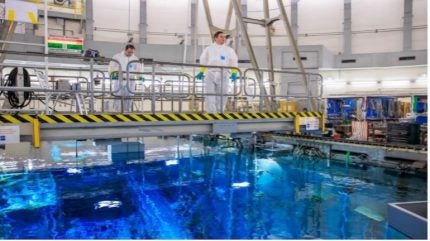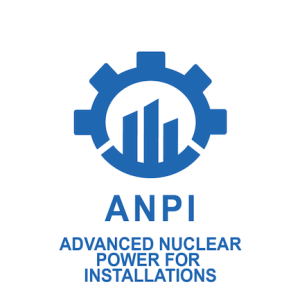
EU-Conversion, a European Union research project is seeking to develop low-enriched uranium (LEU) fuels for research reactors. The project’s goal is to secure the supply of medical radioisotopes and ensure the long-term operation of research reactors.
The fuels that will be tested under the EU-Conversion & PrepHALEU project include:
- High-loaded uranium silicide fuel (U2Si3) – a fuel with a thick fuel core and a thinner cladding; and
- Monolithic uranium-molybdenum fuel (U-Mo).
The reactors involved in the project are Germany’s FRM-II research reactor, which currently uses fuel enriched to over 95% uranium-235; and France’s Jules Horowitz (JHR) – a proposed material test reactor, the first criticality of which is expected in the 2030s. This project aims to secure supply chains by providing safe, low-enriched uranium (LEU) fuels for conversion from highly-enriched uranium (HEU) needed for radioisotope production, and as fuel for advanced reactors currently under development.
The project is funded through the Euratom Research & Training programme and received funding of €12.8m ($13.3m) from the EU Horizon 2020 research and innovation programme under grant agreement ID: 945009.
The aim is to build trust with nuclear research and support organisations, and develop advanced computational methods for nuclear safety, consolidate fuel qualification data, conduct representative tests, and establish efficient supply chains for advanced research reactor fuels. An international master’s programme involving leading European and international universities aims to significantly improve training in nuclear technology topics.
The project kick-off meeting was held at the Representation of the Free State of Bavaria to the EU in Brussels. The PrepHALEU project focuses on establishing an independent supply chain for high assay low enriched uranium (HALEU) within Europe. HALEU is critical for the future of nuclear medicine production, ensuring a stable and reliable supply of isotopes that support healthcare across the continent.
EU-Conversion is being conducted in collaboration with leading nuclear organisations including:
- Germany’s Technische Universität München (TUM);
- France’s Atomic Energy Commission (CEA – Commissariat à l’énergie Atomique et aux énergies Alternatives);
- France’s Framatome,
- Institut Laue-Langevin (ILL) in France;
- Université Grenoble Alpes in France;
- Belgium’s Nuclear Research Centre (SCK-CEN);
- France’s TechnicAtome;
- Centrum Vyzkumu Rez in the Czech Republic); and
- Statni Ustav Radiacni Ochrany (SURO) in the Czech Republic.
NRG Pallas (Netherlands) also attended the kick-off meeting. Representing NRG Pallas at the meeting were Frodo Klaassen and Ronald Schram, who engaged in discussions about the project’s scope and future impact. NRG Pallas in a statement said it “is proud to participate as a partner in this strategically important project, alongside other irradiators and processors across Europe”.
Yoann Calzavara, ILL project coordinator said ILL “is a world-leading large-scale research facility of enormous importance both for radioisotope production and for fundamental and applied research in a variety of fields including physics, chemistry, materials science, biology and health, energy and environment, nuclear and particle physics, and quantum technologies”. He added: “Our goal is to operate Europe’s most powerful research reactor with the innovative low-enriched fuel in the future – with the same scientific performance as before.”
Within EU-Conversion, ILL is mainly involved in work package WP3, which aims to demonstrate sustainable fuel supply chains for the European health physics research reactors (HPRRs) and multi-purpose research reactors (MPRRs), primarily in the domain of monolithic uranium–molybdenum and high-loaded uranium silicide fuel. The fuel selected for the conversion of the ILL’s reactor is a high-loaded uranium silicide fuel at 4.8 gU/cm3 with a thick fuel core and a thinner cladding. The aim is to demonstrate the production feasibility and the yield on a larger scale, with a geometry suitable for irradiation in ILL’s reactor. The material needed is 35 kg of LEU metal to be supplied by the ILL, which will be owner of the raw materials, plates and manufacturing scraps.
ILL is also involved in work package WP4, whose general objective is the irradiation of two test assemblies, one with a monolithic uranium–molybdenum fuel element and the other with high-loaded uranium silicide fuel plates, under high-power irradiation conditions relevant for the reactor-specific fuel qualification of current and future European HPRR and MPRR.
The Belgian nuclear research centre SCK-CEN said the aim of the project is to accelerate the conversion of high-performance research reactors by testing candidate low-enriched uranium fissile materials. To do this, the consortium is using SCK-CEN’s BR2 research reactor. “We can simulate specific irradiation conditions in our BR2 research reactor. This allows us to test the safety and reliability of the developed nuclear fuels in representative conditions,” explained Jared Wight, programme manager at SCK-CEN.
With respect to the reactor conversion of the German research reactor FRM-II and the prospective French material test reactor Jules Horowitz, Wight said the nuclear industry “is making efforts around the world to reduce the use of highly enriched uranium as fissile material, which is intended to prevent a potential spread and proliferation of this material”. Most reactors have already been converted. “Now it’s time for the last few – including these two reactors. It’s a tough challenge, however, because of their specific technical specifications. But it’s a challenge we intend to overcome in part with the help of our BR2 research reactor.”
SCK-CEN will also test the U-Mo and U2Si3 as potential fuels. The research centre will expose both candidate materials to extreme irradiation conditions. “Previous irradiation testing of the candidate materials was limited to a heat flux of 470 watts/cm2. This allowed us to test them in normal, operational conditions. In this EU project, we go a step further and increase the heat flux to more than 500 Watts/cm2. We will exceed the normal operational limits to evaluate how the fissile materials behave under extreme conditions required by FRM-II and JHR,” said Wight
EU-Conversion builds on three previous projects – EU-QUALIFY, LEU-FOREvER and HERACLES-CP. This initial project, HERACLES-CP, focused on understanding the behaviour of UMo dispersion fuel under irradiation, laying the foundation for further development of high-density LEU fuels. LEU-FOREvER aimed to advance production technologies for both dispersion and monolithic LEU fuels, including U3Si2 fuels. EU-QUALIFY further qualified the LEU fuels developed in the previous projects, ensuring their suitability for use in research reactors.
FRM-II currently uses fuel enriched to over 95% uranium-235 to generate its dense neutron flux and such HEU is seen as a proliferation risk. TUM has agreed with the German government and the Bavarian State – which finance the reactor – to work towards converting it to fuel with lower enrichments when a suitable fuel is available. This is a condition of the reactor’s operating licence, which was issued in 2003.






